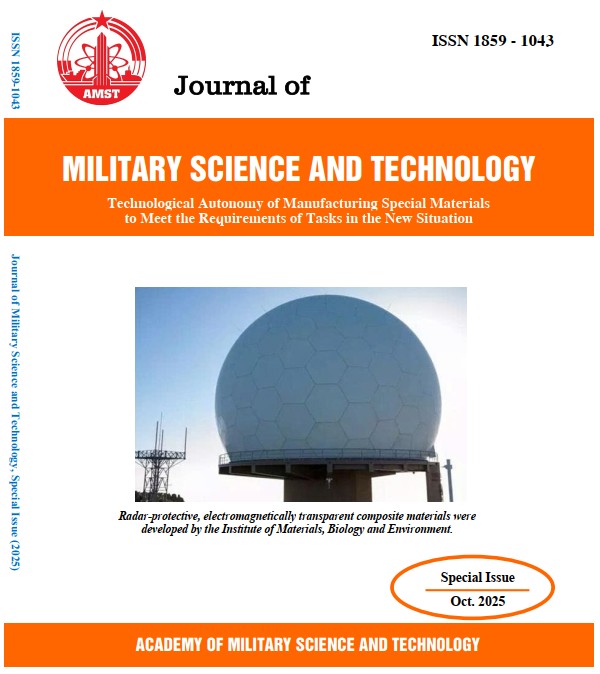Nghiên cứu ảnh hưởng của các chất biến tính bề mặt bột nhôm, dùng trong hệ sơn Epoxy để bảo vệ chống ăn mòn cho nền thép
DOI:
https://doi.org/10.54939/1859-1043.j.mst.IMBE.2025.56-62Từ khóa:
Bột nhôm; KH-792; APTES; Lớp phủ epoxy; Khả năng chống ăn mòn; PDP.Tóm tắt
Nghiên cứu này khảo sát khả năng chống ăn mòn của lớp phủ epoxy chứa bột nhôm (Al) được biến tính bề mặt bằng các hợp chất silane, cụ thể là 3 aminopropyltriethoxysilane (APTES), N-[3-(trimethoxysilyl)propyl]ethylenediamine và 3-(2aminoethylamino)propyl-dimethoxymethylsilane (KH-792). Quá trình biến tính được thực hiện trong dung môi isopropanol có bổ sung natri metasilicat, nhằm cải thiện khả năng phân tán và tính tương hợp của vảy nhôm với nền epoxy gốc nước. Lớp phủ được tạo trên nền thép CT3 bằng phương pháp phun. Việc xử lý silane giúp cải thiện sự phân bố chất độn, tăng độ bám dính và giảm khuyết tật vi mô, trong đó hệ epoxy–Al–APTES cho hiệu quả bảo vệ tốt nhất với điện thế ăn mòn (Ecorr) dịch chuyển về phía dương và mật độ dòng ăn mòn (icorr) giảm đáng kể. Cơ chế bảo vệ được xác định là sự kết hợp giữa hiệu ứng rào cản vật lý, bảo vệ anot hy sinh của nhôm và tăng cường liên kết chéo nhờ tương tác hóa học giữa silane và epoxy. Các đặc trưng của bột nhôm biến tính được phân tích bằng các kỹ thuật SEM, EDX, FTIR và XRD, trong khi khả năng chống ăn mòn được đánh giá thông qua phương pháp phân cực thế động và phổ tổng trở điện hóa (EIS) trong dung dịch NaCl 3,5%.
Tài liệu tham khảo
[1]. Chopra et al., "Recent advances in epoxy coatings for corrosion protection of steel: Experimental and modelling approach—A review," Materials Today: Proceedings, 62, pp. 1658–1663, (2022).
[2]. J.-h. Liu et al., "Corrosion resistance of waterborne epoxy coating pigmented by nano-sized aluminium powder on steel," Journal of Central South University, 19(1), pp. 46–54, (2012).
[3]. M. Q. Zhang et al., "Improvement of tribological performance of epoxy by the addition of irradiation grafted nano-inorganic particles," Macromolecular Materials and Engineering, 287(2), pp. 111–115, (2002).
[4]. M. Toozandehjani et al., "Aluminum composite powder as an additive in epoxy coatings for enhancement of corrosion protection of carbon steel," Journal of Central South University, 31(3), pp. 723–736, (2024).
[5]. U. Abdus Samad et al., "Corrosion resistance performance of epoxy coatings incorporated with unmilled micro aluminium pigments," Crystals, 13(4), p. 558, (2023).
[6]. H. J. Kim et al., "Enhancement of mechanical properties of aluminium/epoxy composites with silane functionalization of aluminium powder," Composites Part B: Engineering, 43(4), pp. 1743–1748, (2012).
[7]. B. Salgin et al., "Role of surface oxide properties on the aluminum/epoxy interfacial bonding," The Journal of Physical Chemistry C, 117(9), pp. 4480–4487, (2013).
[8]. D. Saber et al., "Enhancement of barrier and mechanical performance of steel coated with epoxy filled with micron and nano alumina fillers," Materials Research, 25, p. e20210413, (2021).
[9]. J.-q. Huang et al., "Incorporation of Al₂O₃, GO, and Al₂O₃@GO nanoparticles into water-borne epoxy coatings: abrasion and corrosion resistance," RSC Advances, 12(38), pp. 24804–24820, (2022).
[10]. S. Feliu Jr., "Electrochemical impedance spectroscopy for the measurement of the corrosion rate of magnesium alloys: Brief review and challenges," Metals, 10(6), p. 775, (2020).







